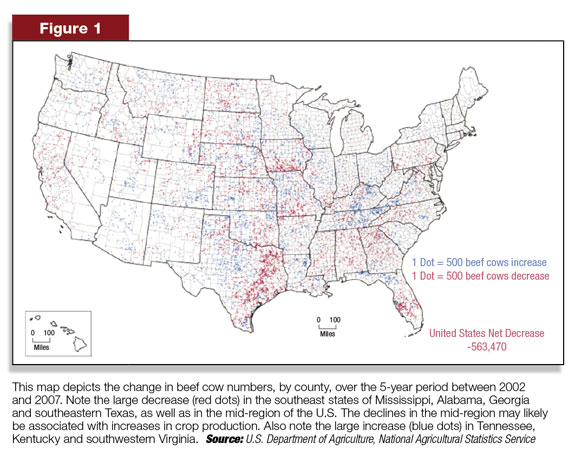Due to the large differences in terrain, climate and motivation for owning beef cows in the U.S., it naturally follows that variation exists.
In this study, ERS uses data from USDA’s 2008 Agricultural Resource Management Survey of U.S. beef cow-calf operations to examine the structure, costs and characteristics of beef cow-calf producers.
The survey covered 22 states and targeted beef cow-calf producers with at least 20 beef cows on the operation during 2008. Here are a few highlights from that report: (Click here or on the image at right to view it at full size in a new window).
- Beef cow-calf production in the U.S. is widespread, occurring in every state.
- Nearly 765,000 farms, about 35 percent of the 2.2 million farms in the U.S., had beef cows in 2007. Most of these were small, part-time operations.
- About one-third of farms that raise beef animals had a beef cow inventory of less than 10 cows; more than half had fewer than 20 cows and nearly 80 percent had fewer than 50 cows.
- About 60 percent of U.S. beef cow-calf farms produce calves that are sold at or shortly after weaning. These are usually small farms and most are located in the Southeast and Southern Plains. Many of the farm households on these operations generate most of their income from off-farm sources.
- More than one-third of beef cow-calf farms retain ownership of calves after weaning and continue grazing, or backgrounding, the calves from 30 to 90 days before selling. These farms are generally larger, have more beef cows and are distributed throughout the U.S., with many in the Northern Plains and West regions.
- The majority of U.S. beef cows are located in the South, including the Southern Plains (primarily Texas) and the Southeast. These regions have the advantage of a longer grazing season and less need for supplemental forage to support beef cattle during the winter, which results in lower feed costs. Despite higher feed costs in the Northern Plains, large beef cow-calf producers in this region are able to compete with those in the South due to production efficiencies and economies of size.
- Economies of size in beef cow-calf production suggest that farms have an incentive to become larger. However, the significant land area required for large-scale beef cow-calf production inhibits many producers from expanding. In most areas of the U.S., beef cow-calf production is the residual user of land. As the opportunity cost of pasture and range land increases for uses such as crop production or recreational activities, the size of beef cow-calf operations may be limited or fragmented into smaller units.
- Most farms with beef cows do not specialize in beef cow-calf production. In 2008, cattle production accounted for less than 40 percent of the average farm product value on U.S. beef cow-calf farms. Regionally, cattle production accounted for about two-thirds of farm product value on beef cow-calf farms in the Southern Plains and West regions, but less than 40 percent in other regions. Specialization in cattle production increased with farm size and peaked at 60 percent of farm product value for operations with 250 to 499 beef cows. Among the largest operations – those with 500 or more cows – less than 50 percent of farm product value was from cattle.
- Operators of more than one-third of beef cow-calf farms worked off-farm in 2008, and half of beef cow-calf farms are classified as rural residence farms. These farms are small operations that specialize in beef cow-calf production but report off-farm earnings as the primary source of household income. Commercial farms with beef cow-calf enterprises are mostly diversified farm operations on which cattle are a secondary enterprise that accounts for about one-fourth of farm product value. On intermediate farms, which have annual farm sales under $250,000 and report farming as the main occupation, the beef cattle enterprise accounts for over half of farm product value. Intermediate farms are among the most financially vulnerable to the input and output price variations of beef cattle production.
The authors of the report further state: “These findings suggest that operators of beef cow-calf farms, large and small, have varying goals for their cattle enterprises, of which farming as a lifestyle choice is not uncommon.”
During the past year there has been much discussion about the decrease in the number of beef cows in the U.S. There are many reasons for this decrease, including increases in feed prices, drought, high prices for cull cows that have drawn lower-producing cows to be harvested for beef and many other factors.
It will be interesting to see how the diverse beef cow owners noted in the ERS report respond to current and upcoming signals.
My guess is that we will always have a large population of “rural residence farms” that crave the slower pace away from the city and enjoy the lifestyle associated with owning a few cows.
On the other side of the spectrum, I believe the profit potential associated with production efficiencies of large-scale cow-calf operations will continue to drive increases in that sector.
Recent projections indicate that heifer retention is beginning to occur. I wonder what the diverse structure and organization of U.S. beef cow-calf farms will look like 10 years from now. ![]()
PHOTO
In most areas of the U.S., beef cow-calf production is the residual user of land. The ability to utilize more acreage is a leading factor in whether an operation can expand. Photo by Progressive Cattleman staff.

Jack C. Whittier
Beef Management Systems
Colorado State University







